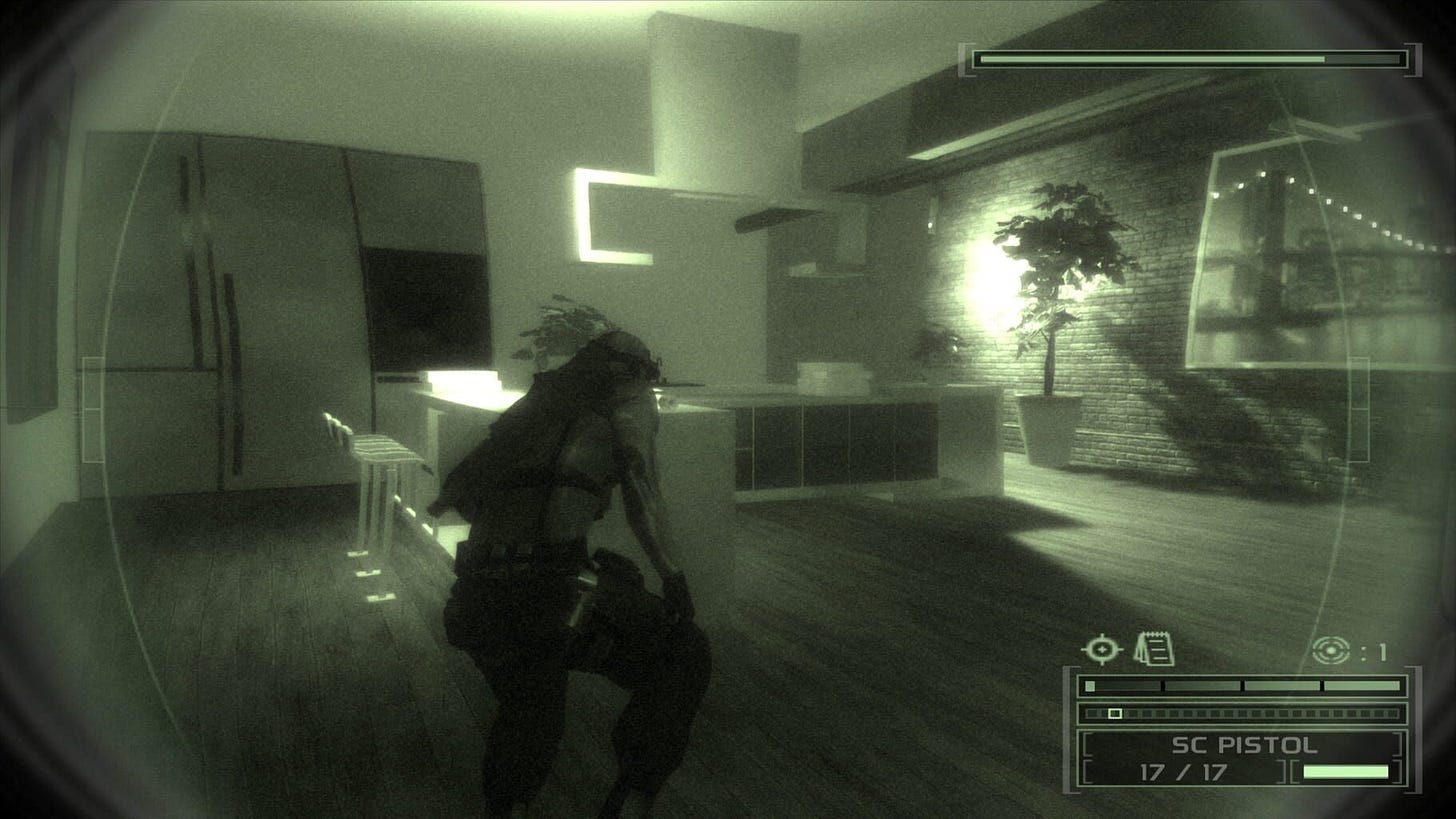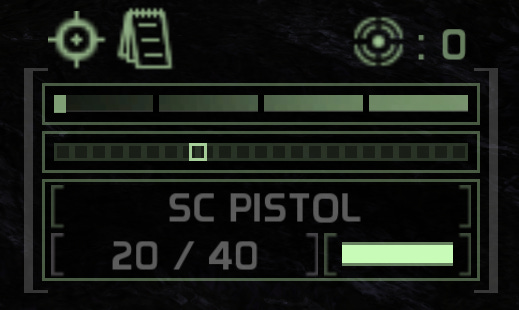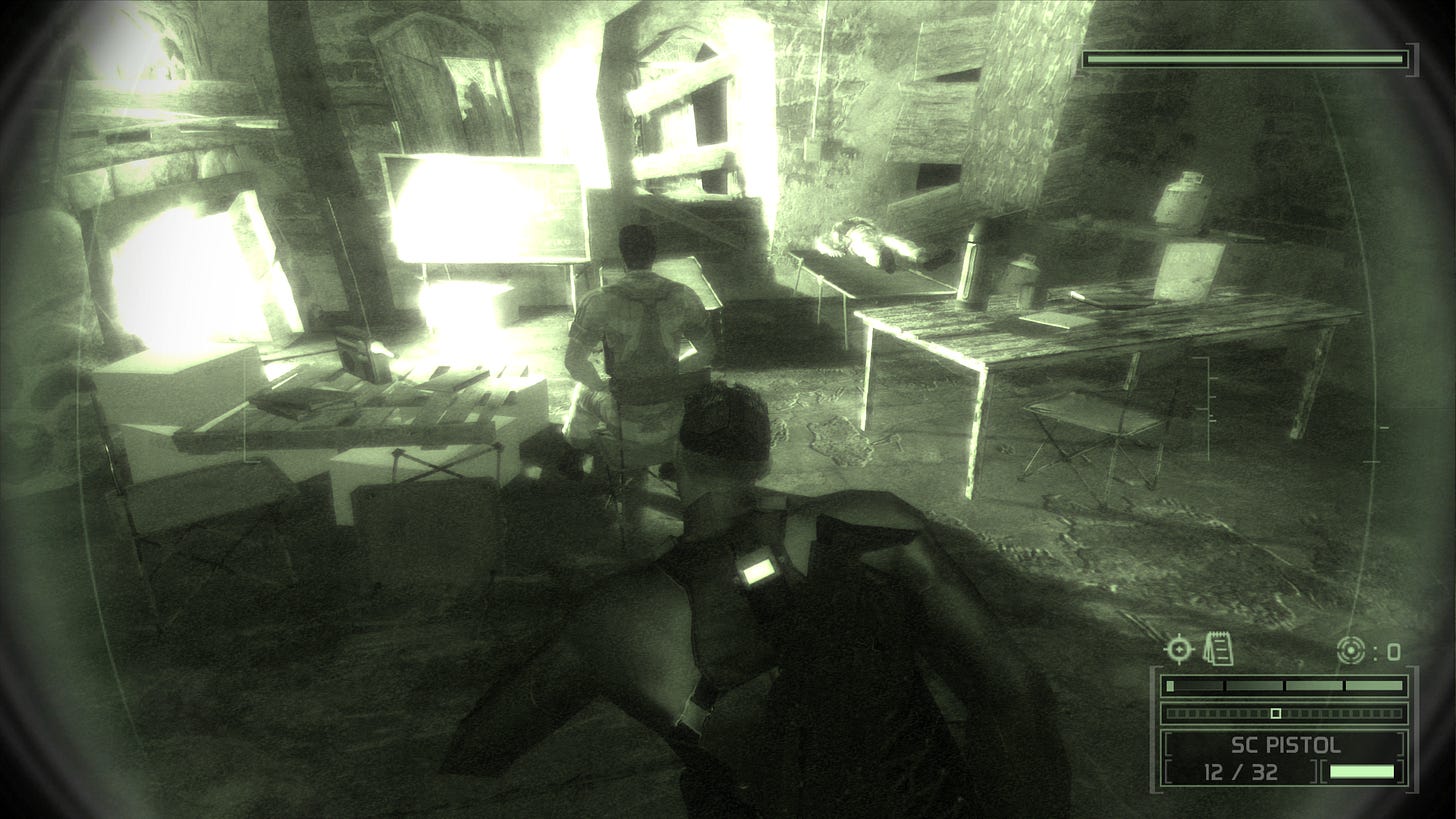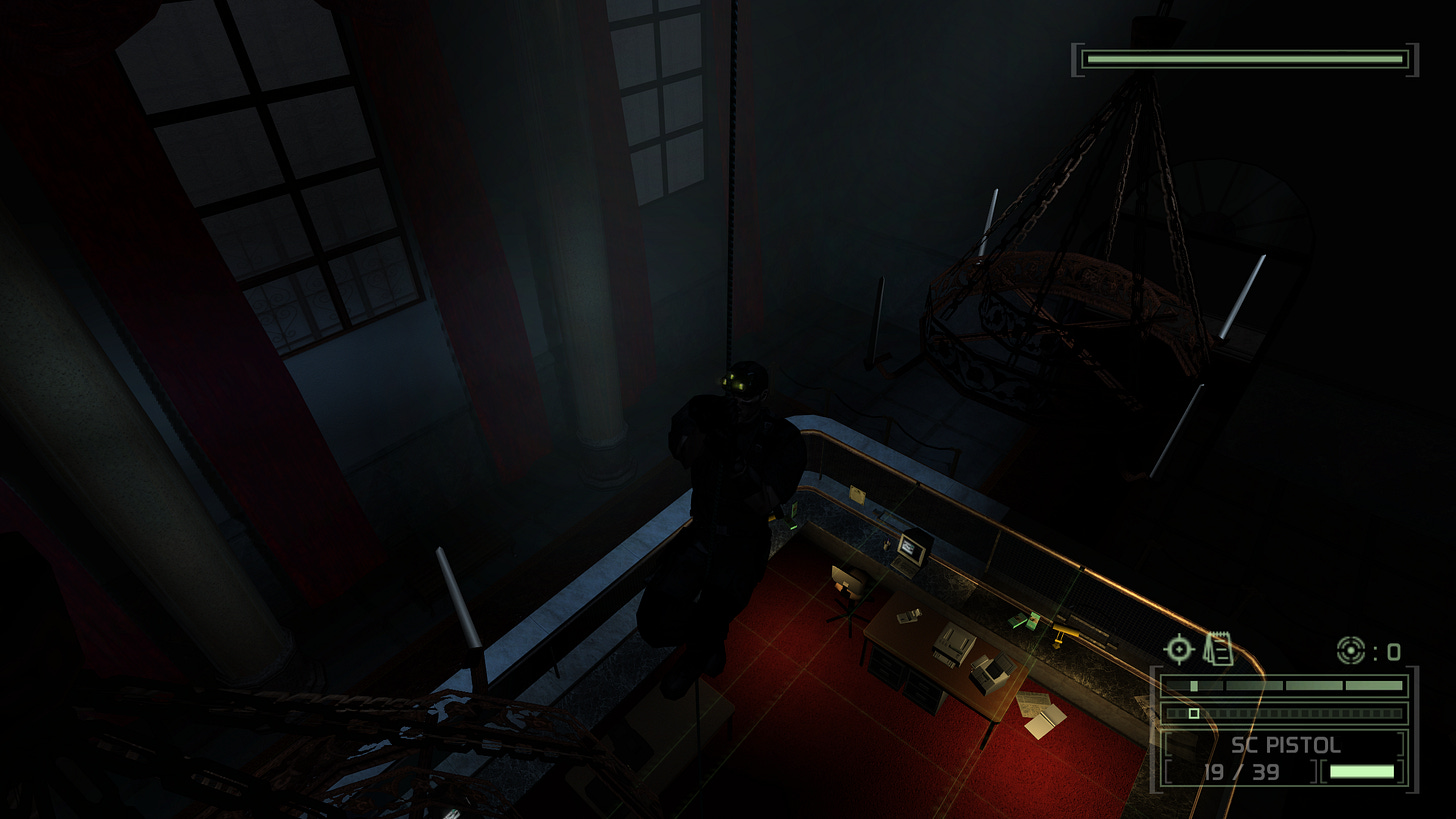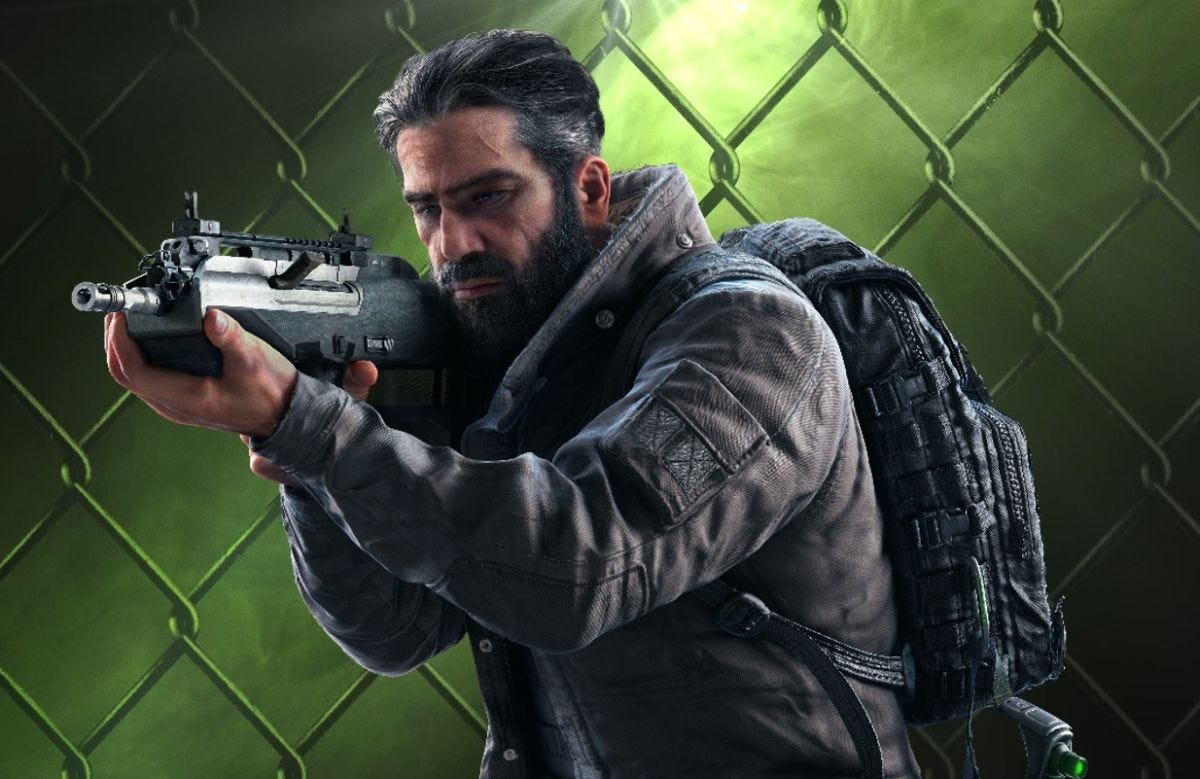Splinter Cell: Chaos Theory and the Power of Perfection
Ubisoft's third entry in the iconic Splinter Cell franchise is the studio's greatest triumph, a bittersweet masterpiece that modern game design has forgotten.
Chaos theory, in its simplest terms, is the idea that even insignificant changes in initial circumstances can cause dramatically different outcomes. Contrary to instinct, chaos theory is not about randomness, or the study of such. Chaos pops up in often unexpected places. Chaos theory, by extension, is the study of chaos where it occurs in mathematics and the mathematics of physics. In essence, where a system that is understood becomes irregular.
Chaos theory, as applied to deterministic situations, is the principle that any slight change in the starting conditions can cause incredibly large changes in the system's state further down the line.
The video 1000 Chaotic Balls is a microcosm of this theory. The balls are positioned so closely together at their origin point that they appear as a single sphere. When they begin to bounce, wildly different patterns are produced. They are actually placed in ever so slightly different positions, with imperceivable degrees of separation. It takes less than half a minute for this system to become visually incomprehensible.
The idea of The Butterfly Effect is a subset of chaos theory that has made its way into popular culture. The idea that the delicate flapping of a butterfly’s wings could influence the formation of a devasting tornado many weeks later is one that easily lends itself to endless contemplation on ideas like fate and free will.
Any slight change in the starting conditions can cause incredibly large changes in the state of the system further down the line
Splinter Cell: Chaos Theory does not choose this name simply for aesthetic ideals or for its surface-level integration into the game’s narrative. Rather, it is emblematic of how the game will be played and understood. Each level is a system that behaves in entirely predictable ways, save for the player. You can rely on the fact that any specific action you take will cause the same outcomes repeatedly. Those actions, and your agency in their deployment, are the element of chaos.
In Chaos Theory, every decision made, every bullet fired and every gadget deployed is the flapping of a butterfly’s wings. And a decision made at the beginning of any level can quickly become a tornado.
Part One - Superspy 101
Splinter Cell: Chaos Theory is a stealth game released in 2005. Unlike more contemporary titles like the Dishonoured franchise or the 2014 Thief reboot, Chaos Theory is a stealth title through and through. Sam Fisher, the protagonist of the game and series, always has at least two firearms at his disposal, though flagrant and aggressive use of these is a tactic that the game is eager to dissuade as quickly as possible. In fact, despite my five complete playthroughs of the game, I cannot think of a single occasion in which I used the automatic rifle to dispatch enemies, aside from the very first.
The first time I attempted to use my automatic rifle to dispatch two enemies, I killed the first one immediately. The second one returned fire, firing wildly into the darkness as I placed another accurate shot. In almost all action games and many quasi-stealth games, this would be fine, even correct. The enemies in the next room would not hear this scuffle, and I would be free to proceed.
Five other enemies heard the gunshots and came rushing to the location, and even in the darkness, I was immediately spotted. A very short gunfight later, and four remained while I lay dying.
I tried again, this time dispatching one more soldier before dying. Repeat. Three men are still standing. One more try and finally, I was through. The next room presented the same core conundrum, recontextualised. After two failures to clear this room, I stopped and closed the game for eight months, assuming (with no hint of ego) that the lauded masterpiece was actually rubbish and that I was the only one who could see through it.
The first lesson is simple and applies to every encounter in Chaos Theory. Sam Fisher is an expert at many things, and he can approach situations in whatever way you desire, but he is not a Call of Duty protagonist. He will be shot a handful of times before dying. There is no health regeneration mechanic, and traditional health packs are few and far between. His skill set is vast: His firearms are a failsafe.
Take a look at the above image, the game’s HUD. The top scale displays how well-lit your current location is. The left is total darkness. Nothing and no one can see you, and enemies can come shockingly close without discovery. On the right, you’re a coal miner in a country club. The rectangle dynamically updates, giving you tangible and reliable information to help you obscure your position.
The meter below that is the sound, not just of Fisher’s movement, but the outlined square is the ambient sound of the environment. In a shootout, this rectangle will be stuck to the right side of the screen. Here, in Lighthouse’s cave with its cavernous echo and the chit-chat between soldiers, a decent amount of audible cover is provided.
The HUD provides a level of clarity and tangibility that is almost entirely lost in modern titles. Not only does it ground you in each mission, making them feel like genuine and dynamic environments that move and change independent of your actions and agency, but it gives the player an immense sense of empowerment while removing so much of the messy and unreliable guesswork that other stealth titles (even other titles in this series) drown the player in. Splinter Cell: Conviction’s binary “hidden or visible” system comes to mind as the exact opposite kind of stealth, and it does not evoke fond memories for me, or indeed any Splinter Cell fan.
Chaos theory does not like it when you act like Superman. The enemies are almost hive-minded: When one spots you, almost everyone in his vicinity knows where you are. It is easy to shake them if you’re familiar with the level layout and enemy placement, but when you don’t, you are usually found and eliminated. Ammo is rare, very rare, usually tucked away in obscure corners. On the hardest (best) difficulties, one or two shots are guaranteed death.
These problems are extremely irritating, but are easily remedied: Don’t get caught.
“Splinter Cell” is a designation given to specially trained agents. The game self-describes them as “a sliver of glass… small, sharp, and nearly invisible”. This quote is crucial to understanding what Chaos Theory demands of its player.
If you have to fire your gun, no you don’t.
If you have chosen to fire your gun, you’ve already made a mistake.
It is entirely possible (and I would argue that at some stage it becomes essential) to complete Chaos Theory in its entirety without interacting, directly or indirectly, with a single non-essential character.
There is seldom a more satisfying and powerful experience in gaming than to turn back around to a complex full of armed soldiers, camera-filled hallways, locked doors and alarmed sectors and say “They never knew I was here”.
Urgh, fine. Eight months later. Install, and we’re back.
Part Two - Trial And Error
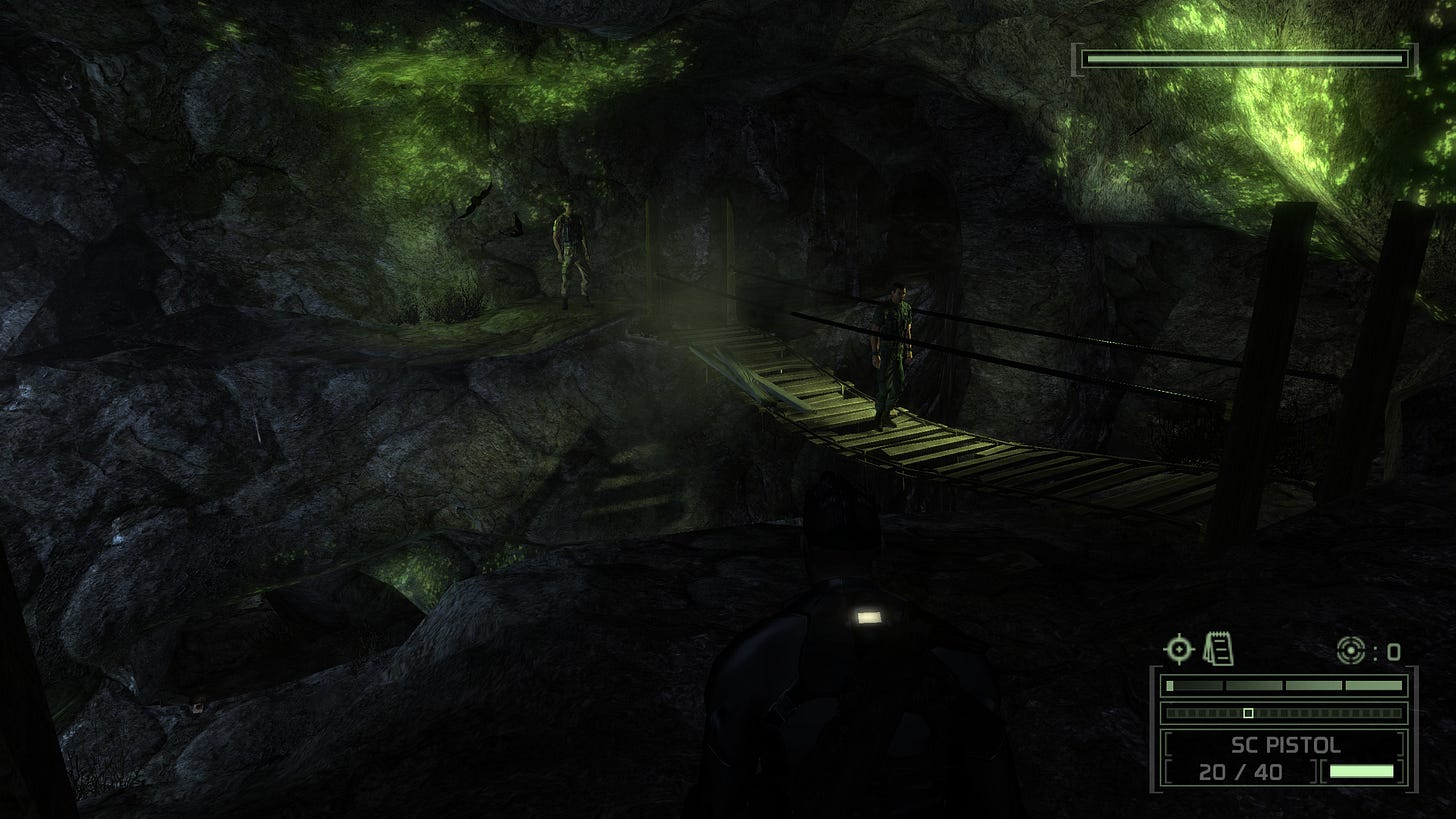
Chaos Theory’s first level, “Lighthouse”, is a carefully constructed introduction. Each section of the level has no more than a handful of enemies, and plenty of space to work with. Unlike many of its later stages, which take place in well-lit and overpopulated concrete structures, Lighthouse is set in the dead of night and mostly in a pitch-black cave system turned military camp.
Enter the cave, and you can interrogate an enemy at knifepoint for immediate clarity on where to go and what to do. This isn’t essential, as Lighthouse is intentionally designed to be completely interconnected. Wait, and like a real soldier on patrol, he’ll move elsewhere. He won’t stand with his back to the only entrance like a placed goon who must be removed from the equation forever.
Lighthouse quickly introduces the secondary objective mechanic, which takes the form of “tagging” various weapons crates around the level. These crates are easy to find and require very little backtracking, though any and all backtracking is entirely possible given the aforementioned interconnectivity. You can either interrogate another guard to be tipped off about these crates or simply stumble across one, which is guaranteed to happen given that at least one is placed in a room that you must traverse through.
Later on, tighter spaces are introduced with various enemies. One room sees you sneaking past two enemies, one sitting and one sleeping. You can kill one or both if you wish: The sleeping man is not woken by a silenced shot or a quick throat slitting, and they are facing away from both the entrance and exit. But the lack of any reason, any incentive to kill is another lesson. Chaos Theory takes the killing of enemies, a given and an expectation in most stealth/action titles, and asks you to decide if you really need to. And once you’ve left an enemy in blissful ignorance in Chaos Theory, you’ll never stop trying to find ways to spare as many lives as possible.
The catharsis of killing, the main entertainment value of shooters and action games, has been replaced. The power trip from taking artificial lives has been replaced with another feeling, the act of mercy. Here, the chaos theory is in full effect. Let’s assume that in the next room, you are detected and need to retreat. Once an unsilenced shot is fired, either by you or a hostile, the sat and sleeping enemies will wake up and join the assault. If you killed both men, then this is a moot point. If you didn’t, then one or two additional armed hostiles in a game that harshly punishes open conflict mean that his room is no longer a potential hiding place, but the exact opposite, turned from a safe haven to a death trap.
This may feel like an unnecessarily grandiose point: Don’t all video games present choices of which the player then deals with the consequences? And yes, while this is true, it’s never more true than it is in Chaos Theory.
Load up whatever Call of Duty is the most recent. See how far you can get without firing a bullet. Not very far, right? Jump onto Grand Theft Auto, and see how long you can go without committing a crime; a similar experience. Chaos Theory’s brilliance is that every level can remain a still lake or a deafening warzone, and anywhere in between. Everyone can live or everyone can die. It can be loud and violent or it can be as quiet as the grave, and none of these possible pairings is mutually exclusive.
Call of Duty is an action game that forces your hand: Chaos Theory is a stealth game that arms you with everything you need to become a walking shadow, but you can really do anything. If you want to flood every room with grenades and smoke and empty scores of bullets into every soldier, you can certainly do that. But be prepared that Chaos Theory has consequences in abundance for every action.
Once you’ve left an enemy in blissful ignorance, you’ll never stop trying to spare as many lives as possible.
Lighthouse’s genius comes from its malleability. It feels designed to be played in two major ways; separate and quietly eliminate the enemy forces, or use the abundance of shadows and space to sneak past totally undetected. It’s a level I generally skip when revisiting Chaos Theory, as it feels a touch too linear after so many playthroughs.
This isn’t to suggest it’s too simple to be enjoyed on repeat playthroughs but is instead a testament to its purpose as a sandbox of sorts. It is an opportunity to take control of Sam Fisher, to learn his abilities and toolkit, to experiment with its impacts on the enemies and to make mistakes and, crucially, to carry these lessons into the rest of the game.
So let’s take these lessons to the greatest level in stealth gaming history.
Part Three - Positively Do Not Blow The Bloody Doors Off
Splinter Cell: Chaos Theory’s third level “Bank”, is legendary amongst stealth game fanatics. It combines a labyrinthian design with sparse but careful enemy placement while providing multiple divergent paths into every major area. A perfect “Ghost” run is not easy, requiring a degree of field recon to digest each room's dangers and careful consideration of each action taken.
Unlike the second level, “Cargo Ship”, which follows a more linear route designed to test the environmental perception skills that “Lighthouse” taught you, “Bank” is far more open-ended.
Backtracking is essential to complete your primary and secondary objectives. As such, your decisions carry even more weight than they have done in previous levels; their consequences cannot be outrun or hidden. A startled enemy you successfully distracted and slipped past may prove a tremendous problem when you later return and find him patrolling on high alert. Certain secondary objectives are hidden in areas of the bank that are incredibly easy to miss, and often only have a single entry and exit point, forcing the player to remember where enemies are placed, where you’ve already been and where you haven’t: It all allows “Bank” to feel like an organic and believable labyrinth.
“Bank” opens with a section just outside the front doors populated with soldiers. The area is in relative darkness, but a new lesson is taught immediately. Moving forward at a decent pace won’t be audible, but it will turn on motion-sensing lights, lighting Fisher up like a Christmas tree. Even if you survive this encounter, the bank is now on high alert and Fisher is likely badly injured.
Interrogating any solider at this beginning stage will inform the player of the motion sensor lights, but Chaos Theory’s trial and error approach is implemented fantastically here. You can simply sneak slower to avoid turning these motion lights on, and veteran players have even routed a specific lane where a speed that matches ambient sound levels but avoids a single motion detection zone can be achieved, avoiding all detection without moving at a snail’s pace. Chaos Theory is steadfast in its rewards for exploration and optimisation, and it’s one of the main reasons the game is so loved: With enough skill, you can actually have your cake and eat it.
Rappeling into the bank from the central skylight presents the player with a laser grid, trapping them in the security room. You can use Fisher’s EMP pistol attachment to disable any specific laser and manoeuvre through it, you can hack a nearby computer to disable the grid, you can jump over the first laser if you’re exceptionally risky and enjoy making things difficult, or you can walk right through it, sound the alarm and begin the massacre.
None of this is explained to you. Fisher doesn’t communicate he’s trapped by a laser grid to his support team, and nobody will suggest any of these solutions to you. Sam’s EMF vision will reveal the origin points of the laser grid, allowing for your EMP to be placed accurately, but other than that, it’s largely a puzzle with multiple solutions. It’s an excellent way to exemplify the feeling of a bank robbery, but it teaches you immediately that “Bank” will be full of traps and puzzles stopping you from completing objectives and making progress.
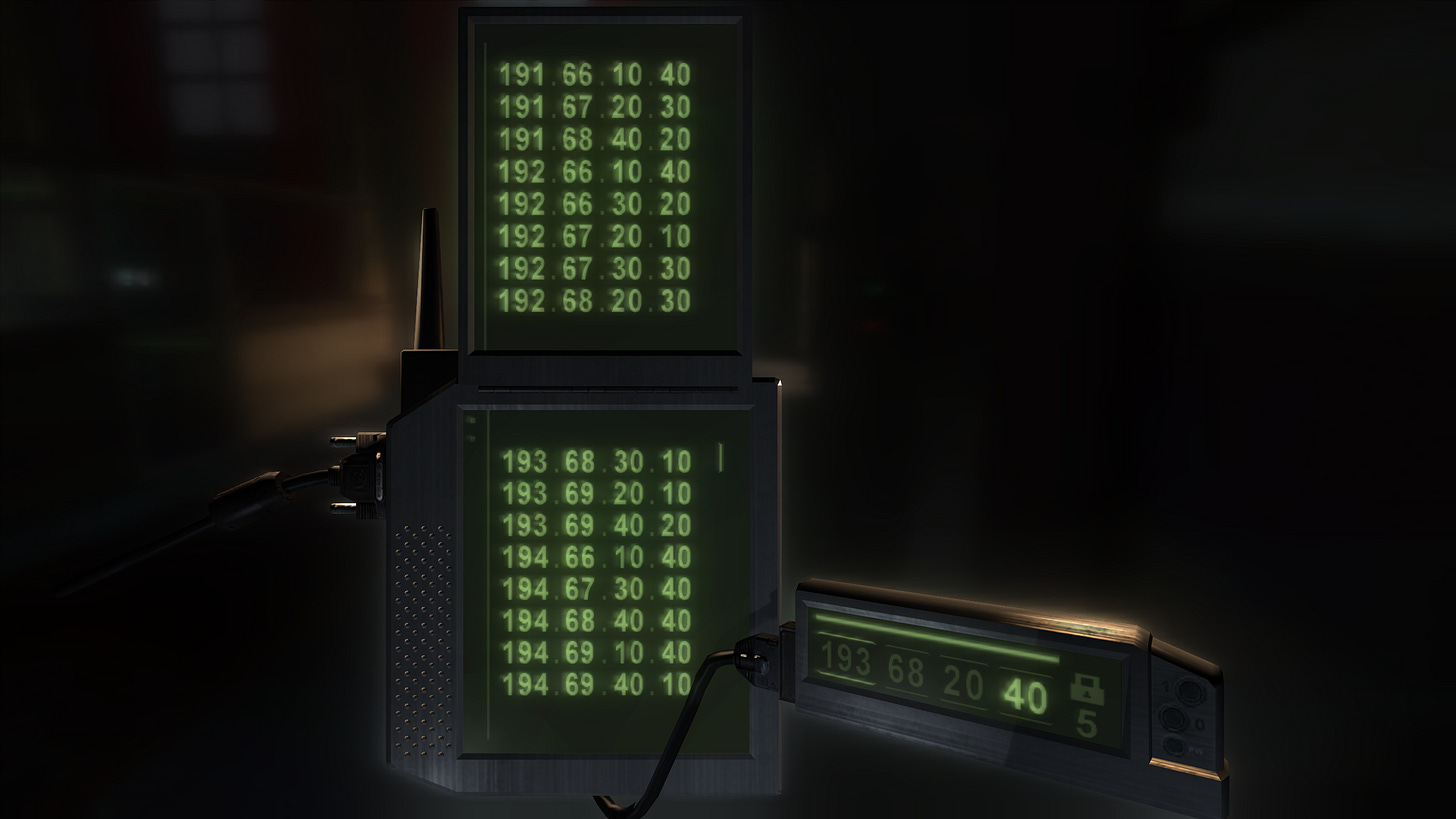
Not a single one of these puzzles has an inherent time limit, but your own actions may force an organic one upon you. Hacking (as seen above) has a “time” bar above your isolated row of numbers, but backing out of the minigame incurs no penalty and resets your progress. However, hacking a keypad carries the inherent risk of human error, where an incorrect input will result in a level-wide alarm. That pressure is tenfold when the enemy is already bearing down on you, and safely backing out and trying again isn’t a viable option.
“Bank” is about control, the maintenance of which allows for calm and measured progress. It can quickly spiral out of control, but it never feels like a coin toss or pure chance. If you played every level in Chaos Theory ten times over before playing “Bank” once, you’d likely still encounter issues and roadblocks. It proves the central thesis of this essay, that Chaos Theory’s greatest success is its predictability. Almost every scenario can be mapped out and accounted for, and experience is king.
Part Four - Where Did I Go Wrong?
Today, Sam Fisher and the Splinter Cell franchise has gone more than a decade without a standalone title, instead becoming something of a sideshow attraction in Ubisoft’s seemingly endless pantheon of fallen titans.
It is an unavoidable truth that pure stealth titles have fallen out of fashion in the last few console generations. Today, perhaps only the Hitman titles are still flying the flag for the genre, albeit with significant concessions to the action crowd. Those games are, first and foremost, assassination simulators, giving players the opportunity to carry out specific murders in as clinical a fashion as possible, a far cry from Splinter Cell’s ruthlessly passivist ethos. There is an emphasis on minimising collateral damage and prioritising efficiency and covertness, but the entire point of each mission is that someone must die, and that is decidedly not Splinter Cell.
Ubisoft’s attempts to revitalise the genre have been few and far between. 2010’s Splinter Cell: Conviction bent the knee entirely to the high-octane action craze of the time, resembling a third-person Call of Duty clone, Splinter Cell in name only. 2013’s Splinter Cell: Blacklist was something of an unholy marrying of old and new, resulting in a fun if confused title, kneecapping itself by refusing to commit to a cohesive vision.
Today, titans of the genre like Splinter Cell and Thief are dormant and likely dead. While Ubisoft has announced a full-scale remake of the original Splinter Cell, information is scarce and the finished project is likely years away, still in pre-production. The commercial value of a hardcore stealth title in 2023 seems a tenuous one, and while many fans (myself included) are excited to hear more about this remake and what it means for the future of the franchise, a glossy action title that simply apes the most visually recognisable elements of the original game while totally changing the formula is absolutely not an unreasonable expectation from a studio that seems hell-bent on squeezing every last penny from each of its releases.
The long-standing Assassin’s Creed title, another heavyweight on Ubisoft’s roster, has also announced Assassin’s Creed: Mirage, a popular yet somewhat bizarre proposition. With the series veering toward a full-scale RPG powerhouse, Mirage is an attempt to recapture the audience that still reminisces about the lone assassins who used to scale the towers of Florence and the cathedrals of Jeruselum, by returning to a formula that has been abandoned since at least 2016: a narrative-focused action title with cohesive linearity, albeit in an open-world environment, though one that pales in comparison to the ones we see today.
It remains to be seen how successful this is, both in terms of audience excitement and commercial engagement, and more crucially whether this concept can work in the gaming landscape of 2023. When the original Assassin’s Creed title was released in 2007, single-player action titles were the flavour of the month and Grand Theft Auto IV had only just been scheduled for release. In 2023, when Grand Theft Auto VI reportedly has an internal budget of a billion dollars before marketing and a development cycle now approaching a decade long, how viable can a formula from the late noughties be, in a world where games are measured by their dollar-per-hour value and internal map calculations?
Splinter Cell doesn’t have the open-world option. It is intrinsically a linear concept, one that requires careful design and balancing of a single-player experience that doesn’t lend itself to the microtransaction-laden modern Ubisoft formula that has utterly infested its entirely contemporary library.
In truth, I have little hope that Ubisoft will deliver a classic Splinter Cell experience again. But it’s hard to worry about the future of the series when Chaos Theory, nearly 20 years later, stands the test of time. The industry has moved on, and a world where Travis Scott hosts virtual concert experiences in a free-to-play cartoon-styled battle royale, the biggest game on the face of the planet, is not one where a commercial titan like Ubisoft is willing to take chances on patient, measured linear stealth titles when billion dollar properties like Assassin’s Creed can be effectively reskinned for three or four years on the trot before a vague PR statement loosely commits to change.
Chaos Theory may not have been Ubisoft’s Fortnite or Call of Duty, but it stands head and shoulders above its contemporaries and successors, an overlooked masterpiece that could have taught the industry so many important lessons about what video games can do that no other medium can. A shining example that stands against the tide of titles that attempt to blur the line between cinema and interactive entertainment, giving nothing but unrestricted and total control over your actions and influence. There are no unskippable cutscenes, no fragments of open gameplay sandwiched between scripted moments.
It is pure agency, the ability to decide who lives and who dies, who knows and who doesn’t. Chaos Theory takes the concept of a video game and realises it to the best of its ability.
Here’s the world, now take it.


